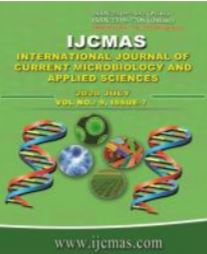


 National Academy of Agricultural Sciences (NAAS)
National Academy of Agricultural Sciences (NAAS)

|
PRINT ISSN : 2319-7692
Online ISSN : 2319-7706 Issues : 12 per year Publisher : Excellent Publishers Email : editorijcmas@gmail.com / submit@ijcmas.com Editor-in-chief: Dr.M.Prakash Index Copernicus ICV 2018: 95.39 NAAS RATING 2020: 5.38 |
Powdery mildew of cucurbits is caused by two causal agents, Sphaerotheca fuliginea (Syn. Podosphaera xanthii) and Erysiphe cichoracearum (Syn. Golovinomyces cichoracearum). To assess the distribution of powdery mildew in major cucurbit crops and also to identify peculiar characteristics of these causal agents, survey was conducted in various places of Coimbatore and Dindigal districts of Tamil Nadu. The collected powdery mildew samples were examined for the presence of conidia and conidiophores. Conidial shapes, conidiophore and conidial dimensions, presence of fibrosin bodies were established by microscopic studies. Based on the conidia and conidiophore characters, two different genera were observed in the samples collected. The conidial mean length of Podosphaera xanthii ranges from 30.51 to 40.88 µm whereas for Erysiphe cichoracearum ranges from 32.08 to 46.87 µm but the conidial mean width of Podosphaera xanthii ranges from 21.28 to 29.65 µm and for Erysiphe cichoracearum it ranges from 16.52 to 29.65 µm. For better perception of host pathogen interaction, pathogenicity assay was proved by detached leaf assay in laboratory and glasshouse in vitro. This prelusive study would be beneficial for early disease discernment and effective management in coming times.
 |
 |
 |
 |
 |